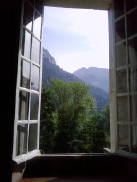As I talked about in a recent post, string theories, and the multiverse models they imply, have been widely criticized for their lack of testability. Some physicists argue that the problem is that the theory is more mathematics than it is physics. Is the distinction becoming fuzzier? And why isn’t that discussed? Why not bring […]
|
|||||
|
Back in July, David Castelvechhi blogged about a conversation between John Horgan and George Musser. I missed it when it was new, but I’m glad I didn’t miss it completely. Most of their discussion focuses on the value or viability of what has come to be known as string theory. It was a thoughtful debate […] A recent Radiolab episode brought some interesting things together by exploring loops, repetitions, and self-referencing phenomena. Among other things, they told the story of Melanie Thernstrom (The Pain Chronicles) who, in trying to manage her pain, investigated the self-inflicted pain of religious rites. She later did some work with neuroscientist Sean Mackey. Mackey had seen […] I feel like I was pulled into a little whirlpool of interesting bits of info this morning. I was attracted to the title of David Castelvecchi’s blog: Archimedes and Euclid? Like String Theory versus Freshman Calculus. The blog reports the opening of an exhibition at the Walters Art Museum in Baltimore, showcasing one of three […] In a recent post on the Scientific American blog network, George Musser reported on talks given by neuroscientists at a conference, organized by the Foundational Questions Institute on how the brain works to construct our sense of past, present and future. Musser’s post made some observations that were familiar to me – like the idea […] David Castelvecchi, at the Scientific American blog network, wrote about a Comment article that appeared in the July 13 issue of the journal Nature. The author, Peter Rowlett, takes note of what could happen when the mathematician “pushes ideas far into the abstract, well beyond where others would stop.” He does this with a collection […] I have often said that I get particular pleasure from mathematics that defies common sense expectations. A simple example would be the observation that two things can be the same size even though one of them is contained in the other – like the set of natural numbers and the set of positive even integers. […] A number of websites have reported on a recent study, that correlated innate number sense with mathematical ability. A concise report of the study can be found in the Johns Hopkins University Gazette, published by the institution where the study was done. The study’s results confirm a correlation between the strength of ones number sense […] I recently listened to a radiolab podcast (from this past November!) that featured two authors: Steven Johnson (author of Where Good Ideas Come From) and Kevin Kelly (author of What Technology Wants). The thrust of the argument, that both authors defended, was that the things we make (from tools to gadgets to computers) are an […] Today, I was working on a piece I’m writing about 19th century developments in mathematics and I saw something interesting. In the piece, I draw particular attention to a few things. One of these is the precision Weierstrass brought to the concept of a limit, removing all references to motion or geometry, and giving it […] |
|||||
|
Copyright © 2025 Mathematics Rising - All Rights Reserved Powered by WordPress & Atahualpa |
|||||


Recent Comments